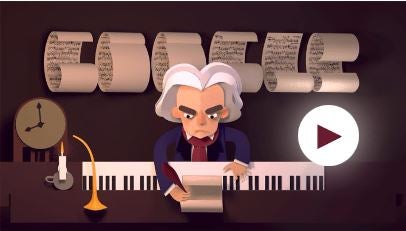Beethoven Google Doodle: How to solve the sheet music puzzle
The internet search giant gives the German composer his own interactive Doodle to mark his 245th birthday

Your support helps us to tell the story
From reproductive rights to climate change to Big Tech, The Independent is on the ground when the story is developing. Whether it's investigating the financials of Elon Musk's pro-Trump PAC or producing our latest documentary, 'The A Word', which shines a light on the American women fighting for reproductive rights, we know how important it is to parse out the facts from the messaging.
At such a critical moment in US history, we need reporters on the ground. Your donation allows us to keep sending journalists to speak to both sides of the story.
The Independent is trusted by Americans across the entire political spectrum. And unlike many other quality news outlets, we choose not to lock Americans out of our reporting and analysis with paywalls. We believe quality journalism should be available to everyone, paid for by those who can afford it.
Your support makes all the difference.Google has honoured composer Ludwig van Beethoven with his very own interactive Doodle.
The Doodle, which appears above the search box on the search website's main pages, is in honour of the great virtuoso's 245th birthday.
In it, an animated Beethoven can be seen on his way to a concert with his compositions when he encounters a series of disasters - from horses from to wind - that mean his sheet music gets knocked out of order.
To complete the challenge, you need to help him put them back together.

There are several sheets of paper making up a sample of music from the Fifth Symphony, the Für Elise, Midnight Sonata and the Ode to Joy (or Ninth Symphony) that you need to put in order.
Listen to the music and try to recreate it using the notes.

The top line is for the treble clef - or key - for high notes, and the bottom one is the bass clef for low notes.
Unfilled notes mean that note is longer. The joined-up black notes mean they are shorter and come closer together.
Join our commenting forum
Join thought-provoking conversations, follow other Independent readers and see their replies
Comments